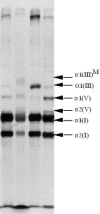Ehlers-Danlos syndrome type IV
- PMID: 17640391
- PMCID: PMC1971255
- DOI: 10.1186/1750-1172-2-32
Ehlers-Danlos syndrome type IV
Abstract
Ehlers-Danlos syndrome type IV, the vascular type of Ehlers-Danlos syndromes (EDS), is an inherited connective tissue disorder defined by characteristic facial features (acrogeria) in most patients, translucent skin with highly visible subcutaneous vessels on the trunk and lower back, easy bruising, and severe arterial, digestive and uterine complications, which are rarely, if at all, observed in the other forms of EDS. The estimated prevalence for all EDS varies between 1/10,000 and 1/25,000, EDS type IV representing approximately 5 to 10% of cases. The vascular complications may affect all anatomical areas, with a tendency toward arteries of large and medium diameter. Dissections of the vertebral arteries and the carotids in their extra- and intra-cranial segments (carotid-cavernous fistulae) are typical. There is a high risk of recurrent colonic perforations. Pregnancy increases the likelihood of a uterine or vascular rupture. EDS type IV is inherited as an autosomal dominant trait that is caused by mutations in the COL3A1 gene coding for type III procollagen. Diagnosis is based on clinical signs, non-invasive imaging, and the identification of a mutation of the COL3A1 gene. In childhood, coagulation disorders and Silverman's syndrome are the main differential diagnoses; in adulthood, the differential diagnosis includes other Ehlers-Danlos syndromes, Marfan syndrome and Loeys-Dietz syndrome. Prenatal diagnosis can be considered in families where the mutation is known. Choriocentesis or amniocentesis, however, may entail risk for the pregnant woman. In the absence of specific treatment for EDS type IV, medical intervention should be focused on symptomatic treatment and prophylactic measures. Arterial, digestive or uterine complications require immediate hospitalisation, observation in an intensive care unit. Invasive imaging techniques are contraindicated. Conservative approach is usually recommended when caring for a vascular complication in a patient suffering from EDS type IV. Surgery may, however, be required urgently to treat potentially fatal complications.
Figures






Similar articles
-
Vascular Ehlers-Danlos syndrome.Ann Genet. 2004 Jan-Mar;47(1):1-9. doi: 10.1016/j.anngen.2003.07.002. Ann Genet. 2004. PMID: 15127738 Review.
-
Cerebrovascular complications in Ehlers-Danlos syndrome type IV.Ann Neurol. 1995 Dec;38(6):960-4. doi: 10.1002/ana.410380620. Ann Neurol. 1995. PMID: 8526472 Review.
-
[Vascular Ehlers-Danlos syndrome].Rev Prat. 2009 Apr 20;59(4):459-61. Rev Prat. 2009. PMID: 19462862 French.
-
Differential diagnosis and diagnostic flow chart of joint hypermobility syndrome/ehlers-danlos syndrome hypermobility type compared to other heritable connective tissue disorders.Am J Med Genet C Semin Med Genet. 2015 Mar;169C(1):6-22. doi: 10.1002/ajmg.c.31429. Am J Med Genet C Semin Med Genet. 2015. PMID: 25821090 Review.
-
[Ehlers-Danlos syndromes. Clinical, genetic and molecular aspects].Ann Dermatol Venereol. 1995;122(4):187-204. Ann Dermatol Venereol. 1995. PMID: 8526413 Review. French.
Cited by
-
A case of vascular Ehlers-Danlos syndrome with a ruptured hepatic artery after surgical treatment of peritonitis caused by the perforation of the colon.Surg Case Rep. 2021 Mar 23;7(1):74. doi: 10.1186/s40792-021-01156-0. Surg Case Rep. 2021. PMID: 33755833 Free PMC article.
-
Spontaneous rupture of breast pseudoaneurysm: a rare case.BMJ Case Rep. 2023 Nov 22;16(11):e256962. doi: 10.1136/bcr-2023-256962. BMJ Case Rep. 2023. PMID: 37993146
-
Vascular Ehlers-Danlos Syndrome with a Novel Missense Mutation in COL3A1: A Man in His 50s with Aortic Dissection after Interventional Treatment for Hemothorax as the First Manifestation.Intern Med. 2019 Dec 1;58(23):3441-3447. doi: 10.2169/internalmedicine.2983-19. Epub 2019 Aug 6. Intern Med. 2019. PMID: 31391389 Free PMC article.
-
A tissue-mimetic nano-fibrillar hybrid injectable hydrogel for potential soft tissue engineering applications.Sci Rep. 2018 Jan 18;8(1):1047. doi: 10.1038/s41598-017-18523-3. Sci Rep. 2018. PMID: 29348423 Free PMC article.
-
Guidelines for the primary prevention of stroke: a statement for healthcare professionals from the American Heart Association/American Stroke Association.Stroke. 2014 Dec;45(12):3754-832. doi: 10.1161/STR.0000000000000046. Epub 2014 Oct 28. Stroke. 2014. PMID: 25355838 Free PMC article.
References
Publication types
MeSH terms
LinkOut - more resources
Full Text Sources
Medical
Miscellaneous

